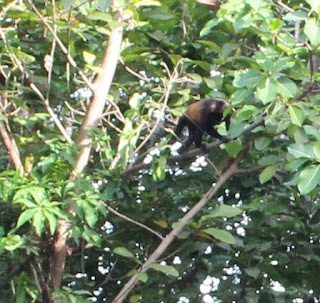Friday, after his flight arrived on time, he rented a car, and as the GPS was slow to kick in, we scrambled a bit navigating through Managua, which has almost no street signs, and few signs to direct the neophyte Nicaraguan. But we managed to find Erlinda's neighborhood, and had a quick visit before heading south to Diriamba and La Boquita.
I thought Bob might want to dine at La Boquita's little beach restaurant zone, and we arrived there after the early sunset and the dark that quickly ensues here in the tropics. It didn't appear that any people were dining anywhere, but we parked and asked a couple of the usual tourist herders if Ronaldo was cooking. I had heard that he prepared good lobster at a better price than anyone else. No, they said. Ronaldo was at home, but his "aunt" could rustle up some lobster. We were guided to an empty elevated pavilion to which a table and chairs were brought, along with cold beers, and we awaited our dinner. I swear we were the only customers in the whole town that night, but we made the most of our impromptu eatery. The lobsters were small, and were served on one large platter, along with rice, plantain tostones and salad. Delicious, really, and we ate our fill. For a Friday night crowd, it seems we were it, and I cannot fathom how those places stay in business. No wonder Ronaldo stayed home!
We rose early Saturday and drove southeast to Rivas, and on to San Jorge, a little port on Lake Nicaragua, which is the largest freshwater lake in Central America, home to freshwater sharks, reportedly. And it is a great lake; one cannot see the opposite banks, and when we were there, white-capped waves dotted the surface, and broke on the shore as do ocean waves. From San Jorge, a ferry takes people and cars to the island of Ometepe, which was formed by a pair of volcanoes.
Bob booked us a package which included being met by a driver at the other end of the ferry ride, and being driven to the El Ceibo museum of pre-Columbian artifacts found all over the island, then to lunch at a beautiful hotel on the western shore of Ometepe, and a visit to Ojo de Agua, a mineral water spring where people swim and dunk themselves for the purported medicinal benefit. And throughout, the lush greenery and dramatic vistas of the two volcanoes: Concepción, the larger, and still smoking northern vent, and Maderas, an extinct vulcan, now topped by a beautiful lake. The two circular island portions are joined by an isthmus, giving the isleta a lopsided hourglass shape.
Bob's photo from the ferry:
(below) from Google Earth.
The Museo El Ceibo takes its name from the large farm in which it is situated. The magnificent ceibo tree stands like a sentinel just off the main road, where a dirt road leads back to a grassy clearing where the museum's wealthy benefactor installed buildings to house a large array of artifacts from the pre-Columbian indigenous population, as well as his own extensive numismatic collection, which we bypassed, neither of us being interested in currency. There must also be an El Ceibo Hotel nearby, according to the sign beneath the tree. The museum opened less than a decade ago.
An obliging docent, Tony, guided us through the centuries of ceramics, petroglyphs, ceremonial and agricultural tools, jewelry, toys, sculpted stone, and funeral containers that compose the museum. I was happy to find I could follow Tony's Spanish narrative pretty well, and it was all very interesting and worthwhile. No mention of human sacrifices, dammit. Bobby wondered if the petroglyphs were scratched by indigenous teenagers, spreading graffiti, to their parents' dismay...
We left the museum and were driven west along the southern rim of Concepción, and our driver pointed out the site of an enormous landslide that occurred a year ago after 40 hours of torrential rain. It took eight days to clear the road, he said, and there are still many uprooted whole trees flung about by the avalanche of volcanic material that gave way. Our destination was the Villa Paraiso hotel at Santo Domingo beach, on the eastern shore of the isthmus. It is aptly named, as it is pretty darned paradisial. Elegant tropical wood structures, lush plantings of flowers and greenery, and even some semi-tame magpie jays who flit about awaiting crumbs from the mostly foreign diners. A welcome breeze blew in from the water, and Bob and I enjoyed a delicious lunch and some decent table wines.
Our avian friend visited our table before dining on fruit from a Veitchia palm just beyond the deck rail.
It was a leisurely lunch, to be sure. We waited and waited for our food, and afterwards, we had only a few minutes to view the mineral water pool before we caught the return ferry at 4 p.m. It was, well, a nice woodland pool, with many happy tourists paddling about, or sitting cross-legged in hippie gauze peasant skirts. Bob spotted a monkey and got this shot:
Then, it was a race against the clock to return to the other side of the island before the ferry left at 4. We made it with 6 minutes to spare. Bob caught a few shots of these fishermen, standing in impossibly narrow boats, casting their nets.
The ferry ride takes about an hour, and we left Ometepe in the embrace of its cloud/smoke canopy. A wonderful day that we concluded with a couple of bottles of wine, some heavenly brie cheese brought from Texas, and crackers supplied by Beth. Early to bed.
and back to San Jorge by sunset.














You guys make a great team - interesting nature and kelcha.
ReplyDelete